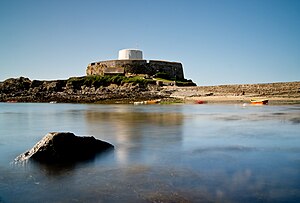Fort Gray
| Fort Gray | ||
|---|---|---|
|
Fort Gray |
||
| Creation time : | 1804 | |
| Castle type : | Coastal fort | |
| Conservation status: | restored | |
| Construction: | Quarry stone | |
| Place: | Saint Peter | |
| Geographical location | 49 ° 26 '21.2 " N , 2 ° 39' 18.2" W | |
| Height: | 6 m ASLTemplate: height / unknown reference | |
|
|
||
Fort Gray , also known as the "cup and saucer" because of its shape, is a Martello tower on a rock in Saint Peter on the Channel Island of Guernsey .
Château de Rocquaine
The French name of the rock is Château de Rocquaine , in Guernésiais Châté dé Rocquoïne . There was a small fort there that was probably built in the late Middle Ages . In the 1620s, it is reported that it was in use by the militia but was not in a condition that suggested it could withstand attack. Local witches' sabbaths were held there in the 16th century and a meeting of a local girl, Isabel Becquet , with the devil was reported in 1617 . Marie de Calais of St Martin was also convicted of being a member of the Coven and burned at the stake on October 17, 1617 .
Fort Gray
The current fort was built on the remains of the old fort. Its white tower was originally built as a defensive structure by the British in 1804, during the coalition wars. The builder was from the area, a Thomas Henry from Clos du Valle . The new fort was named after Charles Gray, 1st Earl Gray , the governor of Guernsey 1797-1807. It was made one of three places on the island to fire warning shots in the event of an invasion.
The tower of Fort Gray, like the other two Martello towers, Fort Saumarez and Fort Hommet , was intended as a donjon for the battery in which it stood. The Martello Towers in Guernsey are smaller than those in Great Britain, Fort Saumarez and Fort Hommet are even smaller than Fort Gray. Each of these towers had a 24-pounder carronade on the roof to protect the battery. Fort Saumarez and Fort Hommet also have external stairs up to the 2nd floor.
The connection between Saint Peter Port and the fort was improved by upgrading the road to military standards around 1808, financed with money from the sale of land in the civilized “Braye du Valle”.
Second world war
The War Department in London sold Fort Gray to the States of Guernsey in 1891 for £ 185 . During the German occupation of the Channel Islands in World War II , the Germans occupied the fort like most of the other forts in Guernsey. The fort was given the German name "Resistance Nest Gray Tower" and was equipped with a mobile 3.7 cm PaK 36 and machine guns.
museum
Fort Gray was later redesigned for more peaceful uses and now serves as the local shipwreck museum ; you will find a number of exhibits from the salvage of famous wrecks, z. B. Prosperity and Elwood Mead . This also includes a Boreas cannon pointing to the nearby Hanois rocks , where the Boreas sank in 1807, killing the captain, at least half of the crew and possibly also the captain's wife. Soon also planks of a Roman ship from the 3rd century AD, which was found in 1982 in the harbor of St Peter Port and which was nicknamed "Asterix", will be exhibited. It took decades to secure the 1,700 year old planks.
protection
The entire Fort Gray and its slipway at Rocquaine were declared a Protected Monument , Reference No. PM238 listed.
Individual evidence
- ↑ James Marr: Bailiwick Bastions . Guernsey Press. ISBN 0-902550-11-X . P. 39.
- ^ Montague Summers: The History of Witchcraft and Demonology . Citadel January 1, 1993. ISBN 978-0-806514-52-9 .
- ^ Richard Strappini: St Martin, Guernsey, Channel Islands, a parish history from 1204 . 2004. p. 8.
- ^ RA Henry: The Reclamation of the Braye du Valle 1806-2006 .
- ↑ Ben Cahoon: Guernsey . Worldstatesmen.org. Retrieved April 6, 2018.
- ↑ a b Fort Gray . Guernsey Museum. Retrieved April 6, 2018.
- ↑ James Marr: Bailiwick Bastions . Guernsey Press. ISBN 0-902550-11-X .
- ↑ The towers of Fort Saumarez and Fort Hommet are 10.2 meters in diameter and 5.1 meters high; Fort Gray has a tower that is 10.8 meters in diameter and 7.8 meters high.
- ^ William H. Clements: Towers of Strength: Martello Towers Worldwide . Pen & Sword, London 1998. ISBN 978-0-85052-679-0 . P. 169.
- ^ William H. Clements: Towers of Strength: Martello Towers Worldwide . Pen & Sword, London 1998. ISBN 978-0-85052-679-0 . P. 87.
- ^ Richard Strappini: St Martin, Guernsey, Channel Islands, a parish history from 1204 . 2004, p. 115.
- ^ Ernie Gavey: German Fortifications of Guernsey . Guernsey Armories. ISBN 978-0-953163-10-6 . P. 37.
- ^ Guernsey's Roman ship moves to Fort Gray . ITV. May 15, 2015. Accessed April 6, 2018.
- ↑ Protected Trees, Buildings and Monuments: PM238 . States Of Guernsey. Retrieved April 6, 2018.
swell
- William H. Clements: Towers of Strength: Martello Towers Worldwide . Pen & Sword, London 1998. ISBN 978-0-85052-679-0 .
- Paddy Dillon: Channel Island Walks . Cicerone Guide, 2011. ISBN 1-85284-288-1 .
- EJ Grimsley: The historical development of the Martello Tower in the Channel Islands . Sarnian Publications, 1998. ISBN 978-0-951386-80-4 .



